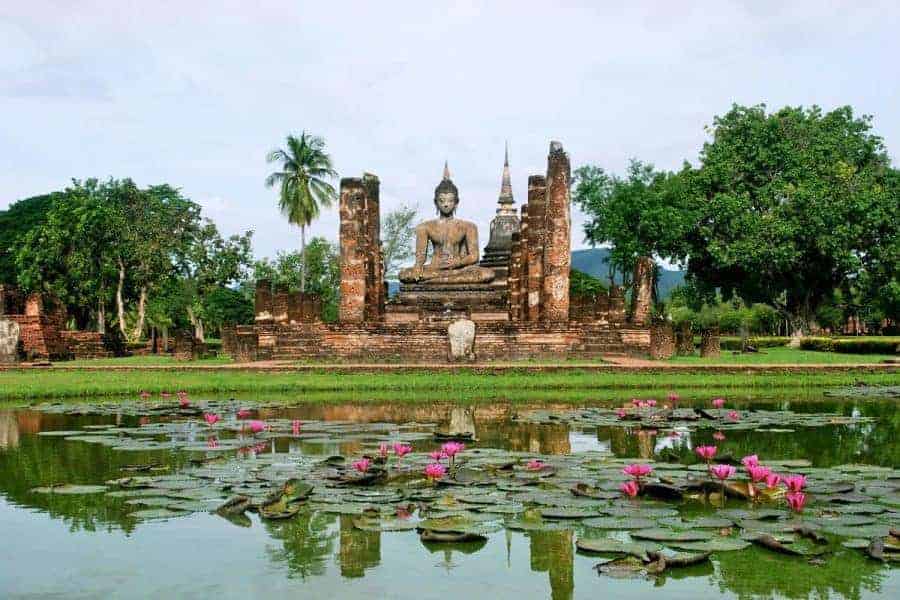Things to See and Do in Sukhothai, Thailand
If you’re visiting Sukhothai, Thailand, you might be wondering what it’s like to live there. Located on the River Yom, this small town sits 12 km east of the historic city of Sukhothai. There are various interesting things to see and do in this enchanting Thai town. While you’re there, check out the historic sites of Sukhothai, Wat Mahathat, Wat Phra Pai Luang, Wat Si Sawai, Wat Traphang Thong, and many others.
Wat Mahathat
There are numerous reasons to visit the ancient temple of Wat Mahathat in Sukhothai, Thailand. The first is its sheer size, as it sits on an island within an artificial moat. The building has a large bell-shaped stupa and reconstructed columns from the ordination hall flank it. There are also several opportunities for taking photographs. The bridge leading up to the temple, and the grassy embankment across the artificial moat, provide the photographer with a variety of leading lines for compositions.
The Sukhothai temple is an impressive sight, displaying incredible craftsmanship. The large Buddha statue, standing at 15 meters, is breathtaking. The temple is the first to feature the Lanka style of architecture. The temple also has a small vihara with laterite pillars. Its spires are a great way to capture the heart of the locals.
The walls of Sukhothai have a fascinating history, and a wall encloses the old inner city. The walls were constructed of three earthen walls and a single gate. This temple, Wat Mahathat, was one of the largest in Sukhothai and contained a huge Buddha statue. It also features five ponds, ten prayer halls, and nearly 200 stupas.
The central stupa of Wat Mahathat was not completed in the thirteenth century, and it is believed that it was built after 1292. The central stupa was not mentioned in the Sukhothai Inscription Number One, but the one dated 1292 mentions it. Si Satha is believed to have written the second inscription and may have given the temple its name about the Buddha relics.
Nearby, visitors should also visit the UNESCO-listed Historical Park, about 34 miles and 55 kilometers away from the ancient city. Sukhothai, which means “city of good people,” is best visited by car, but bicycles can also be rented to explore the park. The park is also home to a large pond, popular for trekking. Moreover, the nearby Thara Wasan Cave is a perfect place to explore the centuries-old stalactites.
Wat Phra Pai Luang
If you love temples, you’ll want to visit Sukhothai Historical Park, which contains thousands of Buddha statues and ancient temples. The pious ruins of this ancient city are unlike anything you’ve seen before. This is the perfect place to see giant Buddha statues and learn about Buddhist history. There are many things to see, including a lotus pond in front of the old temple hall. You can even catch a breathtaking sunset here, thanks to the beautiful silhouette of the temple.
Located in the north of town, the Sukhothai temple was constructed during the reign of Jayavarman VII, the Khmer who built Angkor Thom. Though he was of Indian descent, the Sukhothai temple is of Khmer influence. It was built east-west and was adorned with numerous Buddha statues, including a huge one 15 meters high. Visitors are left speechless as they stand in front of the Buddha statue. The statue is made of brick and gypsum and is seated in a position invoking the goddess of the earth.
Nearby, you’ll find Wat Nang Paya or the Queen’s Temple. Although this temple was dedicated to the goddess Pasuja Devi, archaeological evidence does not support this claim. The ancient stupa and vihara remain, with stucco reliefs carved into the walls. And there’s a statue of King Ramkhamhaeng, the great king of Sukhothai who ruled from 1279 to 1298.
The oldest temple in Sukhothai is Wat Phra Pai Luang, which dates to the 12th century. It is not as well-known as the other temples in the old city, so visitors should plan to visit it later in the day. The sunset here is particularly peaceful. Its history and architecture make it one of the most intriguing temples in Sukhothai.
If you have more time, you can visit the local night market in the central city of the town. This market is located next to the Yom River. The street turns into a walking street at night, with numerous Thai food stalls on both sides. The market is open until 9 pm. You can spend a long evening browsing through the food stalls. You can dance the night away on the purpose-built dance floor at the end of the night.
Wat Si Sawai
In ancient times, this Hindu site was a place of worship. Later, the site was converted into a Buddhist temple with ornate pagodas and Khmer architecture. The intricate details of the temple’s pagodas and architecture are reminiscent of the Hindu style. Visit this temple, and you’ll be enlightened and amazed by its beauty. Once a Hindu sacred site, Wat Si Sawai now holds a Buddhist temple.
Located southwest of Wat Mahathat, Wat Si Sawai is the oldest temple in Sukhothai. Constructed in the late-12th or early-13th centuries, this temple was the site of a sacred Hindu ceremony, the Thiruppavai, before Lawo was liberated and the Sukhothai kingdom was formed. The temple features three well-preserved Khmer prang divided by a gallery. A crypt was also added to the temple.
When visiting Sukhothai, be sure to take water with you. The temperature in Sukhothai is 33 degrees. You should bring a reusable water bottle to help avoid getting dehydrated. Also, remember to bring a camera because the area is crowded. The weather in Sukhothai is quite humid, so pack some sunscreen. It’s best to visit late December or early February when the temperatures are cool. During the hot summer months, the weather in Sukhothai can become extremely hot.
The three Khmer corncob prangs at Wat Si Sawai are a striking feature of the temple. The tall central tower stands fifteen meters high, and the flanking towers are a few meters smaller. The three towers are covered with white stucco and stand on a low gallery. The prangs were built during the Lavo kingdom’s control over the area.
During the reign of Jayavarman VII, a Hindu temple was built at the temple. A Shiva linga, a Vishnu statue, and a yoni were found during his reign. A lintel depicts the Hindu creation myth, in which Brahma sits on the navel of Vishnu. These sacred artifacts are displayed at the Ramkhamhaeng National Museum in Sukhothai, Thailand.
Wat Tra Phang Thong
Visit Wat Traphang Thong in Sukhothai, Thailand. The name means “temple of the golden pond.” It is the only temple within the city’s old walls that is still used today. It has a bell-shaped Chedi and is free to enter. It is an important tourist site and a must-see while visiting Sukhothai.
The golden lake monastery is the most famous temple in Sukhothai, and it is located on an island within the city’s eastern ramparts. You can reach it by a long wooden bridge. Inside the temple, you’ll find a stupa that is a typical Sukhothai style with eight smaller ones surrounding it. The ordination hall is simple but contains a statue of Buddha that was carved into the stone.
The most important temple in Sukhothai is Wat Mahathat, which means “temple of great relic.” It was built between 1292 and 1347 by Sri Indraditya and had an elaborate design. The architecture is based on the mandala, which represents the universe. The main stupa dates back to the 13th century and is surrounded by smaller stupas in each eight directions. The stupa itself is shaped like a lotus bud, and its base is stuccoed with 168 Buddhist disciples.
Wat Si Sawai is the oldest temple in Sukhothai and was built in the late 12th and early 13th centuries. It was the location of a Thiruppavai ceremony before Lawo was freed. It also features a cella and a podium for the lingam. Its ruins and collapsed towers are now open to the public.
The Ramkhamhaeng National Museum is another must-see in Sukhothai. It has an excellent display of Sukhothai’s history and culture. The museum is open from nine to four every day. Admission is 150 THB for foreigners and 30 THB for Thais. The museum is located adjacent to Wat Traphang Thong. Afterward, head over to the moat where Wat Traphang Thong is located.

